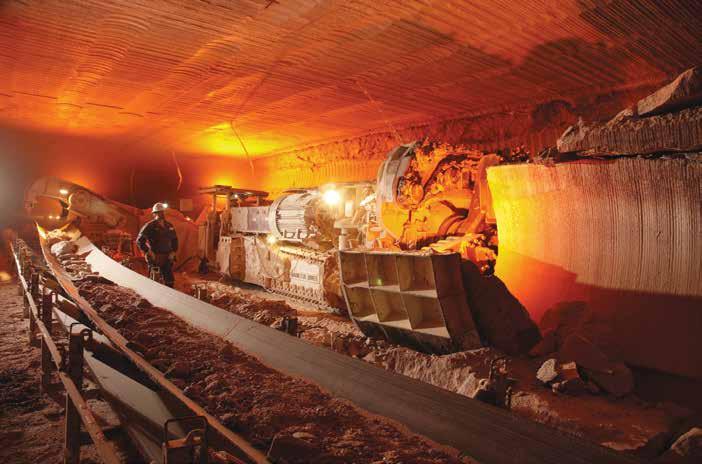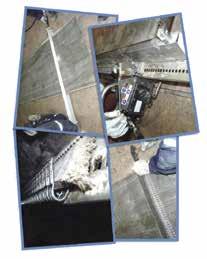
3 minute read
Potash cooling comes full circle
HOW MOVING BED HEAT EXCHANGE TECHNOLOGY CAN HELP IMPROVE YOUR OPERATIONAL ENERGY CLIMATE
BY IGOR MAKARENKO
Potash operations worldwide are in the midst of widesweeping modernizations that are being increasingly fueled by producers’ collective pursuit of a net-zero future.
Cleaner, more sustainable alternatives to traditional practices are emerging throughout the potash production process chain, ranging from sustainable extraction methods to water recycling and everything in-between.
As such, today’s technologies are being expected to do more – and how they do it is just as important.
Moving bed heat exchangers (MBHEs) based on vertical plate technology have long been prevalent at the cooling stage of potash operations around the world – favoured for being robust in their design, efficient in operation, and consistent in producing a high-quality finished product. More recently, these MBHEs are providing potash producers with an important opportunity to recover energy for use elsewhere in the plant. And in doing so, they are further cementing a compelling OPEX case at a time when the industry needs it the most.
How it works
MBHEs based on vertical plate technology start by accepting free-flowing potash into a tower-like unit at temperatures around 120°C or higher. The material, granular or fine, then slowly passes between a series of parallel plates that contain water or other heat transfer fluids flowing counter-current to the potash.
The plates transfer heat from the potash to the heat transfer fluid, cooling the potash as it slowly and uniformly flows downward, controlled by a discharge feeder. The potash exits the MBHE at a temperature of around 60°C or lower.
As the potash is cooled, the MBHE produces a hot transfer fluid that can provide low-grade thermal energy to be used
In this example, the hot transfer fluid produced in an MBHE can be used to pre-heat combustion air, via a preheater, in equipment such as a fluid bed or rotary drum dryer. Photo courtesy of Solex Thermal Science.
elsewhere in the plant. For example, the fluid can be used upstream to pre-heat combustion air via an air-to-fluid preheater used in equipment such as a fluid bed or rotary drum dryer – significantly reducing the amount of natural gas needed.
Alternatively, that thermal energy can be used to pre-heat air that is used to trim dry the potash. This trim drying stage – which occurs after the potash has been processed within a rotary drum or fluid bed, and within the upper section/s of the MBHE – allows producers to meet moisture targets more efficiently. Lastly, the MBHE does not rely on ambient air for cooling and does not need a lot of energy to get the job done. It’s estimated that it takes just 170 kW to effectively cool 100 tph of potash. In comparison, direct-contact cooling methods such as fluid beds or rotary drums require significant air-handling equipment such as high horsepower fans, air chillers, and air pre-heaters. That translates into an energy requirement of as much as 1.7 MW to cool 100 tph of potash – 10 times more than an MBHE. Reducing primary energy consumption, such as natural gas, is at the top of many potash producers’ wish lists. In Canada, for example, it’s estimated that natural gas represents almost 80 per cent of total energy consumed annually within the potash industry – energy that generates both direct and indirect greenhouse gas emissions.
As such, industry players in Canada such as Mosaic Company, K+S Potash Canada, and Nutrien have all pointed to ongoing investments into many different energy-use and emission-reduction initiatives meant to reduce their operating costs, improve efficiencies, and decarbonize their operations.
MBHEs based on vertical plate technology offer an OPEXfriendly solution that can significantly improve a plant’s overall energy climate. In addition to cooling potash with greater efficiency, these MBHEs offer a convenient, straightforward process of reutilizing low-grade energy that would otherwise be wasted.
Igor Makarenko is the global director, fertilizers at Solex Thermal Science. To contact Igor, email him at igor.makarenko@solexthermal.com. s
AMI SUPPLY
JAMIE YAGANISKI Main: 306-652-9878 Cell: 306-227-7414 Email: jyaganiski@amisupply.ca
For more than 25 years AMI SUPPLY has provided the highest quality conveyor belt fasteners, tools and service to the mining industry.
• MATO Belt Fasteners • Belt Cutters and Clamps • Belt Trackers • Belt Cleaners • Safety Nets/Guards












